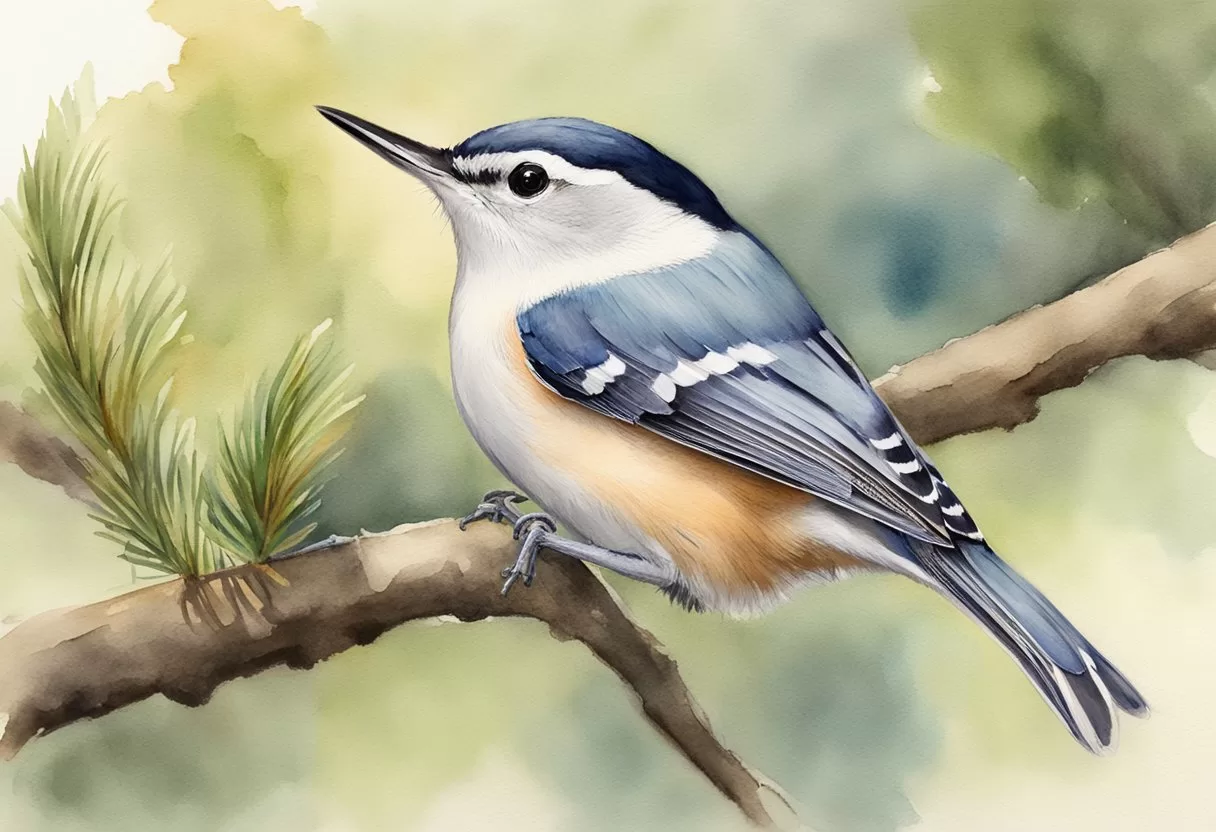Overview of White-Breasted Nuthatch Vocalizations
The vocalizations of the White-breasted Nuthatch serve essential functions in their communication and social behavior. Understanding the structure of their vocal repertoire and the contexts in which these sounds are used provides insight into their interactions and survival tactics.
Defining Vocal Repertoire and Structure
The vocal repertoire of the White-breasted Nuthatch includes a variety of sounds, primarily characterized by their distinct call notes and song patterns. The most recognized call is a loud, nasal “yank,” often delivered in a series. This call varies slightly between sexes and can sound more trembling when calling in other contexts.
In addition to the “yank,” these birds produce softer notes, such as “yinks,” which are often used during foraging or social interactions. The combination of these calls forms a complex vocal system used for a range of purposes, including signaling danger or coordinating social activities.
The Role of Vocalizations in Behavior
Vocalizations among White-breasted Nuthatches play a significant role in various behavioral contexts. For example, their loud calls may serve to establish territory or deter potential intruders. Such communication is vital for maintaining social order in their habitats.
Additionally, softer “yink” calls facilitate communication between mated pairs, especially during foraging. The vocalizations also assist in nesting behavior, where they convey messages about threats or the presence of food. These different sounds highlight the adaptability of the White-breasted Nuthatch in responding to environmental and social cues.
Diversity and Adaptation of Vocal Signals

The White-breasted Nuthatch, scientifically known as Sitta carolinensis, exhibits a remarkable diversity in its vocalizations that reflects adaptation to various environmental factors. This section explores the variations among subspecies, geographical differences in vocal patterns, and the role of acoustic adaptation in speciation.
Subspecies Variations and Diagnostic Differences
In North America, the White-breasted Nuthatch has several distinct subspecies. Variations in vocalizations have been noted primarily among the eastern subspecies, the Pacific subspecies, and those in the interior west. Each group produces unique calls that serve specific functions, such as territorial signaling and mate attraction.
Diagnostic differences in vocal traits can often help in identifying subspecies. For example, calls from the Pacific subspecies are generally lower in pitch compared to those from their eastern counterparts. These vocal distinctions are crucial for understanding regional adaptations and potential mate preferences.
Geographical Variations in Vocal Patterns
Geographical factors significantly influence the vocal patterns of the White-breasted Nuthatch. Variations can arise from differences in habitat, climate, and species distribution across the range. In regions with dense forests, the wilder acoustic environment may lead to louder and more complex vocalizations, facilitating communication over longer distances.
Different populations of the White-breasted Nuthatch, such as those inhabiting the eastern U.S. and the Pacific coast, showcase unique adaptations in their calls. The interplay between environmental pressures and vocal behavior is significant, contributing to the species’ overall vocal diversity.
Acoustic Adaptation and Speciation Factors
The acoustic adaptation hypothesis suggests that variations in vocalizations enhance survival and reproductive success. For the White-breasted Nuthatch, vocal adaptations may play a crucial role in speciation, especially as genetic variation among subspecies becomes evident.
This phenomenon can lead to barriers in gene flow, as differing calls can influence mate selection. For instance, nuthatches that produce distinctive calls may avoid interbreeding with other subspecies, promoting further differentiation and speciation. Thus, vocal signals serve not only in communication but also as a driving force in the evolutionary process of this species.
Scientific Research and Technological Advancements
Recent studies have significantly advanced the understanding of the White-breasted Nuthatch’s vocalizations. Through innovative methodologies and the integration of technology, researchers are enhancing their analyses and expanding the body of scholarly work in this field.
Methodologies in Studying Nuthatch Vocalizations
Researchers employ various methodologies to study the vocalizations of the White-breasted Nuthatch, including field recordings and laboratory analysis. These practices often involve the use of audiospectrograms, which visually represent sound frequency and patterns. Frequency measurements allow scholars to quantify differences in calls among subspecies.
Additionally, studies like those found in JSTOR offer valuable insights into historical data and vocal analyses. Digital archives, such as the Macaulay Library, serve as resources for students and researchers aiming to compare calls across geographic ranges. This combination of fieldwork and digital resources enhances the understanding of vocal variation linked to ecological factors.
Impact of Technology on Avian Studies
The influence of technology on avian studies, particularly for the White-breasted Nuthatch, cannot be overstated. Information technology has improved the efficiency of data collection and analysis. Advanced software programs allow for precise analysis of vocalization patterns.
Tools such as mobile applications enable researchers to record and analyze vocalizations from remote locations. This leads to enhanced productivity in studies. The collaborative nature of modern research fosters a rich environment for scholars to share findings and insights, further enriching the field of ornithology. These advancements empower a new generation of students and researchers to explore avian communication with unprecedented depth.
Share this content:

Post Comment
You must be logged in to post a comment.